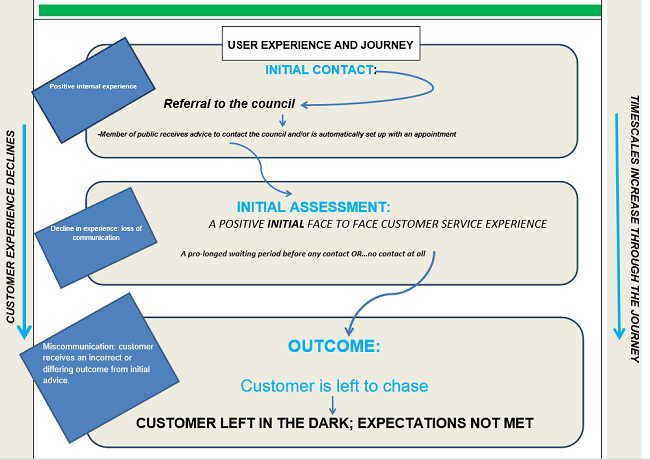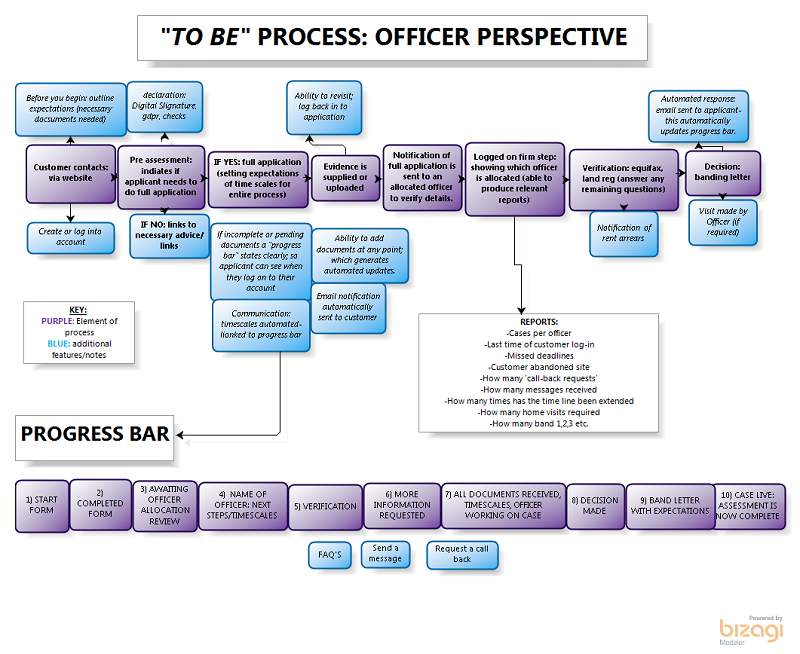This project has had to pivot products from one back office system to a new overhauled alternative. This refocused approach provided the team with a solid foundation of experience and resource that will now be embedded in the change programme of the housing IT system. The department will now benefit from the work carried out by the team as the housing system innovates over the upcoming year.
Constructive Outcomes
User testing and engagement
A critical input into the project was from the user testing sessions. The team had to start from scratch when they set out to develop the template for the online housing application form. The team started with user testing sessions to capture disciplined customer engagement.
The customers highlighted that they held limited understanding of the initial stages of the application feeling ‘left in limbo’ and unsure of the process. As a result, the team developed an integrated progress bar in the form and CRM to give customers a better understanding of the process as well as identifying opportunities to update customers directly from the back office when updating the status of an application. The team reflected that using the customer’s voice had a valued influence on the design process heavily increasing the chances of designing the right product, first time.
Figure 1.0
Ingraining familiarity and logic into processes
The application registration process had to be drastically altered from the manual process to the new digital format. The team collaborated with the Kent Home Choices Manager to establish a starting point for this aspect of the project. This input allowed the council to understand that a bespoke integration into the council’s CRM would be the best outcome. This would accommodate the system that allows customers to carry out activities such as ordering recycling bins and paying council tax, providing the user with a level of system familiarity. Through the successful user testing sessions, the team were able to identify a series of refocused questions for the application form that differed from the original format. It enabled the team to ingrain a logical flow and structure into the questions that made sense from the customer’s perspective within the familiar CRM portal.
Discovery Days and digital champions
In order to ensure that system specifications and logical questions were developed and appropriate the housing service hosted internal discovery days with frontline staff. The officers that dealt with customers daily were invited to map out the main concerns and issues with the processes that a user would typically encounter in a triage or housing application appointment.
The days were received well by some colleagues who began to champion the change journey, others found it more difficult to grasp the aim of the digital housing project. The discovery days allowed the team to begin to alter mindsets and create digital champions for the work they were delivering by helping to persuade other colleagues to buy into the ethos of the project and assist with delivery.
Furthermore, the team highlighted the importance of identifying who the appropriate stakeholders were within the project. For instance, operational managers often had a preconceived idea of what they felt needed to change and found it difficult to see beyond the day to day work. A clear facilitator from the project team to instigate change made the discovery days effective and required the service to provide them with the data needed to drive the project forward.
Figure 2.0
Challenges
Conflicting housing legacy systems
The project manager coordinating the digital housing initiative was also leading an improvement project reinvesting in the council’s back office housing system that fed information and data into the online forms. The system had been procured 10 years prior and required a comprehensive review in functionality and specification. This pushed the project team to examine the contract to evaluate whether the council was receiving value for money. This project has had a considerable impact on the form delivery timelines.
At this early stage of the improvement project, the directorate has decided to move data and forms onto an alternative system from Firmstep to Northgate. This has meant that work on the digital housing project from the LGSS developer and project team which was built in Firmstep including the housing application and wireframe will have to be started from phase 1 in the new Northgate system. This is due to the complexity of the interoperability between the Northgate and Firmstep systems as well as the Northgate solution being identified as having longer term benefits and opportunities for further digitalisation of services.
The project team and senior housing colleagues were forced to calculate the payoffs of transferring the housing systems. The new system will have more functionality for other key elements of the service. The team are optimistically looking to harness the learning from the Firmstep processes in order to replicate the progress of the original product as closely as possible, within the limits of the new system. It was a risk at the beginning of the project to pursue the Firmstep route which unfortunately has meant the team has had to reset the workstream to push on with the delivery of the forms in the new system. This time however, the team have the benefit of the expertise and learning from already developing similar products.
Constraints of buy in
The project team when reviewing the progress to date, felt that they received pushback from some colleagues involved in the project. There were clearly some concerns and adversary about the change that can be inherent when digitising services. Staff in organisations often feel threatened when digital is used to channel shift services that could be perceived to replace human positions. On reflection the team could have benefitted from senior stakeholders using their influence to explain the vision of freeing up staff from routine, mundane tasks to focus more on those where they can really add value to residents. The team reflected that this resistance may contributed to the delay in reaching the current position of the project. It is examples such as this that indicate that when digitising services getting change management right is of crucial importance to ensure maximum impact.
Resource and expertise lost
As the project progressed in Firmstep the LGSS developer delivering for the team left the organisation. The developer had been involved from the inception of the project and fully understood the user journey, the logical line of questioning in the triage tool and how the wireframe structure flowed. The risk register for the project had mitigated for this threat by planning to rely on different and further resource from the LGSS service. However, LGSS found themselves unable to provide dedicated resource back into project development leaving the team in a stagnant position. With the developer resource unavailable it prompted the project team to approach the system development differently. This ultimately contributed to the decision to opt for the Northgate migration as it would double up on resources in a smart and efficient way.
Resourcing and scope creep
The project also suffered from resource strain where the project manager was occupied with the two major improvement projects in addition to multiple smaller projects and their day job requirements. This strained the flexibility of the project team and their ability to dedicate resource in the most meaningful way. The impact on delivery for the triage and housing assessment forms suffered and as the system migration began to grow in scope more attention was diverted from the digital housing work. A lesson learnt from the project team is to fully scope and prioritise the requirements and resourcing to ensure pressure is equally distributed across the delivery team.
Benefit realisation
As the project evolves over the coming year under the Northgate system and the forms are launched the team already have the baseline of the former manual processes pre-launch and COVID-19. Using the Socitm “Potential for Channel Shift in Local Government” report the projected savings can be estimated through the channel shift of customer engagement from manual to online. In three years after launch with full channel shift the council is estimated to save over £114,981. As the sector moves to entrench digital services post-COVID-19 these savings can be predicted to continue increasing.
Key Tools and Approaches
The business process mapping approach that the team employed over the discovery days with staff proved to be useful in gaining buy-in from colleagues into the change journey. The mapping helped prove how complicated and onerous the processes were, by enabling the housing frontline officers to spend time reflecting on their working practices and the day to day steps in the physical housing applications. The session was led by an officer, directing the different learning sets to demonstrate how a user would put an application into the system and the difficulties faced from their perspective.
How valuable was the input from the local government supplier (SDS)
The team found the early stages of replicating the assets challenging due to the starting point they found themselves in. SDS coordinated workshops for the programme which were designed to give the PMs of each project the starting skills to be able to deliver the initial stages of the project. The support the MKC team received from LGSS was able to supplement the initial help provided by SDS especially when they began to develop the wire frame.
The team appreciated the guidance but were comfortable to rely on support from a similar organisation with comparable expertise closer to home. They felt that the initial learning curve was extremely steep and the support from SDS and LGSS contributed in a positive way to the delivery of the project. The team were appreciative of this input which put into perspective the scale of change they were trying to implement.
Replicating the Kent digital asset
The MK PM visited the Kent Homes Choices team for an asset demonstration where they received advice and guidance that helped steer the project team in the correct direction for customer research and logic questioning. Colleagues at Kent Home Choices became a reliable contact for the project team providing answers to their queries and directing them to relevant services to contribute to the asset development. This working relationship has continued to develop and has led to collaboration on Kent Home Choices next phase of their triage work maintaining links between the two teams as they continue to develop their separate yet interlinked projects.


